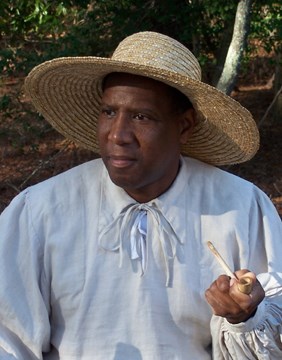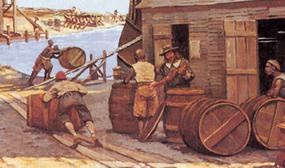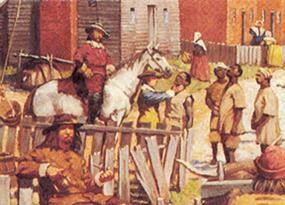|
The Start of English Slave Trade As early as 1618, King James I had granted a patent to a company that wanted to trade for gold and precious woods in Africa. Other groups also received rights to trade in Africa, but never dealt with slaves in any major way. English involvement in the slave trade would intensify after 1663, when a new patent was issued to the Company of Royal Adventurers. England had realized the money to be made trading slaves to the West Indies and Virginia. By 1668, over a quarter of the new company’s profits was derived from the slave trade. 
NPS image
Africans in Virginia’s Early Years The first documented arrival of Africans to Virginia was in 1619, when an English warship, White Lion, arrived at Point Comfort in present-day Hampton. The African captives had been forcibly removed from a Portuguese slave ship subsequent to being attacked by the White Lion and another English warship, Treasurer, while sailing in the Bay of Campeche. The White Lion's English captain, John Jope, carried letters of marque from the Dutch Prince Maurice making it legal for his ship to sail as a privateer and attack any Spanish or Portuguese ships it encountered. The "20 and odd" Africans on the White Lion were traded to colony officials for food. These Africans were much-needed workers to cultivate tobacco, the new cash crop of Virginia. The institution of slavery slowly crept into Virginia legislation. By 1660, slavery as we think of it today was established in Virginia. Tobacco was extremely labor-intensive, and more and more workers were needed. The sale of Africans to Virginia planters promised to be a profitable endeavor.

NPS image The Company’s Beginnings At first, trading directly with other European countries was common in Virginia. But the Navigation Act of 1660 brought such relations to a close. Only English-owned ships could enter colonial ports. The Crown had realized the wealth that could be achieved through trade and wanted that wealth for England. Once the Navigation Act was passed, Virginia planters were forced to rely on the Mother Country to supply them with their labor force. To address this dearth, the Royal African Company was formed in 1672. 
NPS Image Agents in Jamestown Merchants in London associated with residents of Jamestown were also heavily involved in the slave trade. John Jeffreys, one of these merchants, owned part of a rowhouse in New Towne, and historians speculate that slaves were sold in front of the building on a wharf. The Royal African Company also had agents in Virginia to whom slaves were delivered. These agents received a seven-percent commission on sales. John Page, Colonel Nathaniel Bacon and William Sherwood were all prominent Virginians who served as factors, agents or representatives for the Company. The Company’s Decline Many factors contributed to the loss of the Royal African Company’s monopoly in 1689. First and foremost, the Company was not achieving a profit; as a matter of fact, it resorted to borrowing money to pay dividends. Then there were the complaints from the planters. The demand for slaves was always too high for the Company alone to supply, and the planters urged that the monopoly be abolished so that more slaves could be imported. Finally, the Company, which was always heavily patronized by the Stuart monarchs, fell out of favor when James II was deposed and William and Mary came to the throne. Sources Consulted: Donnan, Elizabeth. Documents Illustrative of the History of the Slave Trade to America: Volume I (1441 – 1700). Washington, D.C.: Carnegie Institution of Washington, 1930. Kingsbury, Susan Myra. The Records of the Virginia Company of London (in four volumes). Washington, D.C.: Government Printing Office: 1906. McCartney, Martha W. A Study of the Africans and African Americans on Jamestown Island and at Green Spring, 1619 – 1803. Williamsburg, Virginia: National Park Service and Colonial Williamsburg Foundation, 2003. (This reference is available on-line through this link. Please note this is a PDF document and requires Adobe Reader to open. It is a 4.5 MB file consisting of 262 pages)
|
Last updated: February 26, 2015
